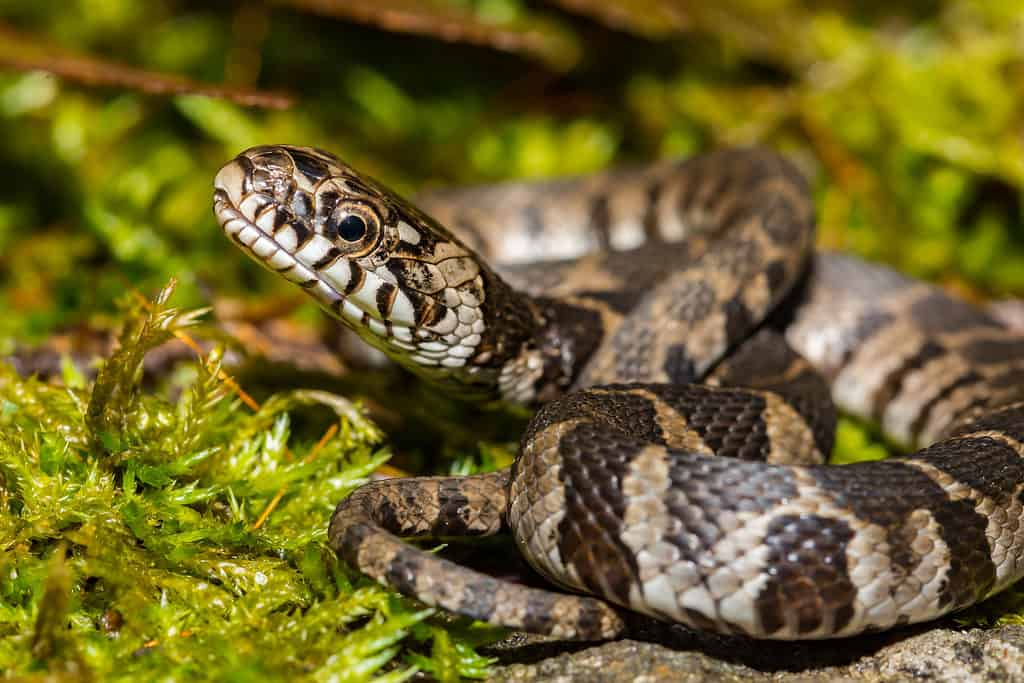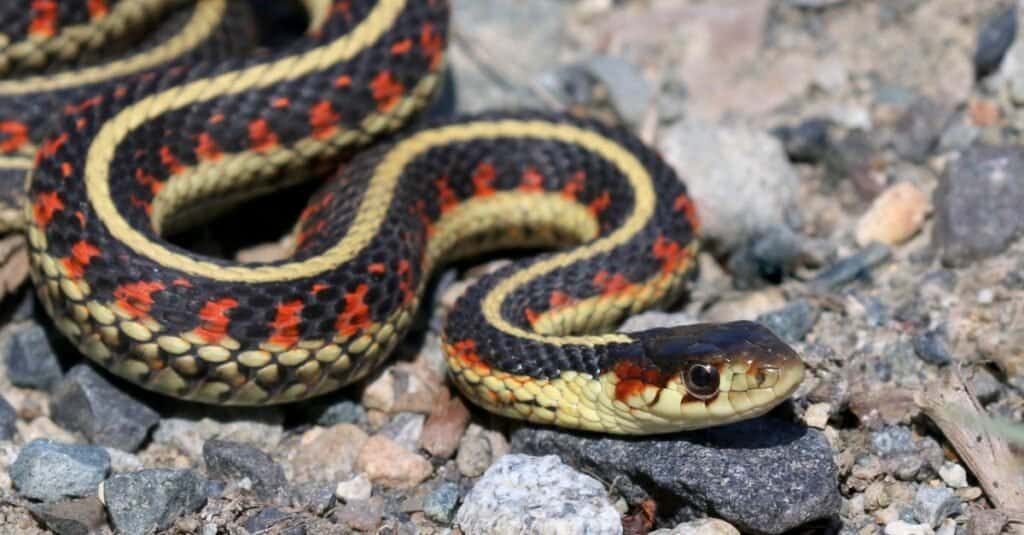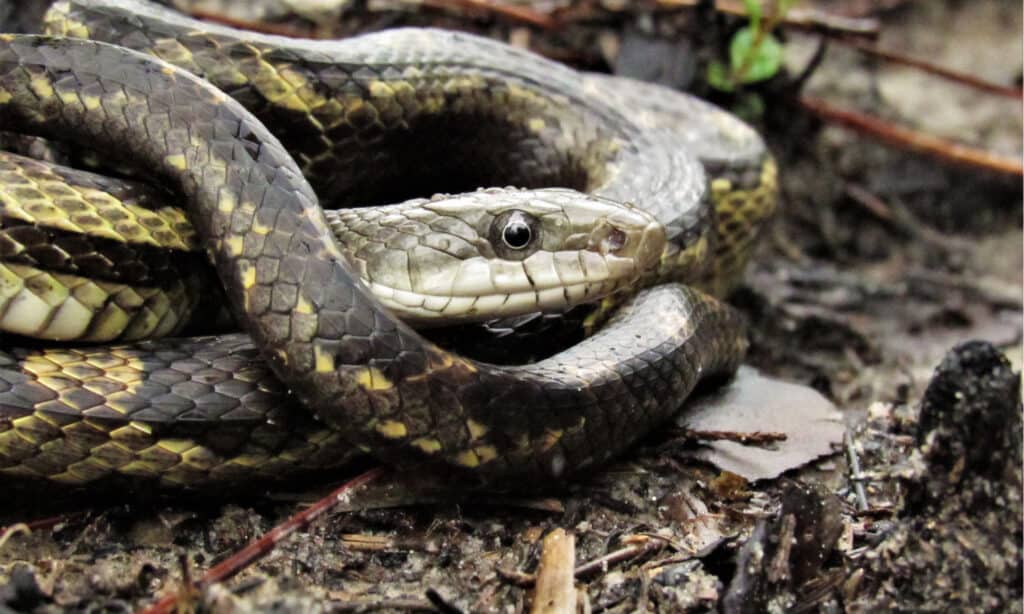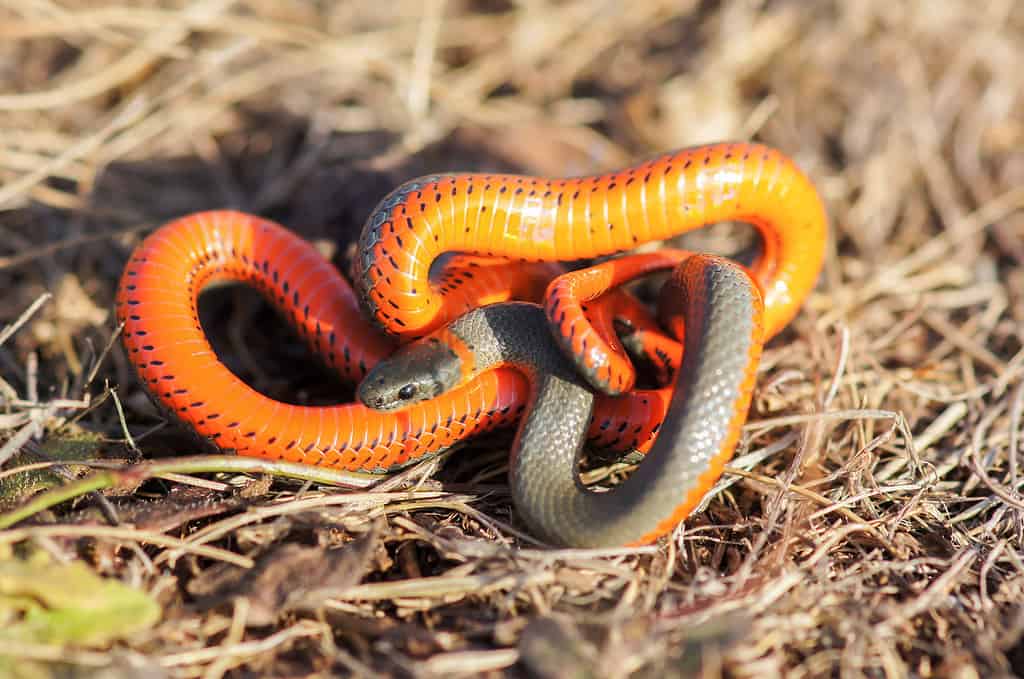Slithering snakes may send chills down your spine, but most of the 4,000+ snake species worldwide are nonvenomous. These legless hunters can get into places that other predators can’t—making them vital for keeping rodent populations in check.
According to the Indiana Department of Natural Resources, Hoosier has 32 native snakes. Four of those snakes are venomous, but you’re not likely to encounter one.
Wondering which snakes you’re spotting in your garden? Read on!
Most Common Snake in Indiana Gardens: Northern Watersnake (Nerodia sipedon)

Common watersnake (Nerodia sipedon) have round pupils.
©Jay Ondreicka/Shutterstock.com
More than most snakes, the northern watersnake gets misidentified as a cottonmouth. In fairness, it’s not the snake’s fault. Northern watersnakes are semi-aquatic, have triangular heads, and the adults often become dark brownish-olive-blackish. However, that’s where the similarities end.
At two to four feet long, watersnakes aren’t the biggest snakes but are thick-bodied and have strongly keeled-scales. Their heads, although triangular, are about the same width as their necks. Juveniles have a lighter base color with darker crossbands. As they age, they darken to a sort of brackish-brown-black color that helps them hide in the water. Northern watersnakes have round pupils, vertical labial (lip) bars, and incredibly sharp teeth.
Northern watersnakes are diurnal and nonvenomous. They eat fish, frogs, and other small animals and spend most of their time in or near the water. They can be found away from water, but since their preferred prey lives there, they do too.
Although nonvenomous, they’re quite happy to bite you. This snake does not like being handled. If you have any doubt, several quick strikes with razor-sharp teeth and anti-coagulant saliva drive the point home. However, they’re not aggressive. Northern watersnakes want to be left alone. They do what they must to make that happen.
More common in and around ponds, rivers, and streams, northern watersnakes are more comfortable on the outskirts of town.
Indiana Garden Snakes: Common Garter Snake (Thamnophis sirtalis)

Garter snakes have large heads with small eyes.
©iStock.com/randimal
Appropriately named, common garter snakes are one of the most widespread species in North America. Garter snakes hunt daily, slithering in, out, and under leaf litter and debris. This species is thin and long—reaching four and a half feet long at times.
Garter snakes come in a wide range of colors, but nearly all of them have a dorsal stripe and two more stripes along each side of their body. Their stripes range from pale cream to bright orange along each side spot.
They’re stinky snakes because they often musk the moment they are touched. Pick one up, and you’ll likely be washing your hands soon after.
While they’re not dangerous to people, garter snakes have mildly venomous saliva that is dangerous to the amphibians and other small animals that they eat. They’re not aggressive; while they sometimes bite, it’s not dangerous and only causes mild irritation.
Common garter snakes are shy and often try to escape when they realize you see them. They’re often found in and around gardens, moist areas, and near water.
Gray Ratsnake (Pantherophis spiloides)

Gray rat snakes often reach six feet long; they’re one of the few rat snake species that keep their juvenile pattern into adulthood.
©Gabbie Berry/Shutterstock.com
The longest snake in Indiana is also one of the most common. Gray rat snakes often reach six feet long; they’re one of the few rat snake species that keep their juvenile pattern into adulthood. However, those in the northern reaches of their range may end up just as black as the eastern ratsnake.
Gray ratsnakes are gray with dark blotches down the length of their backs; the markings on their backs form a rear-facing spearpoint, and a band across their snout covers the eyes. Their bellies are light-colored with dark blotches.
More common in the southern part of Indiana, rat snakes can be found all over the state. Gray rat snakes are rodent hunters-extraordinaire. This snake is an excellent climber and spends a lot of time in the trees, on garage rafters, and scaling walls in search of food.
They’re nonvenomous and harmless to people, but they often startle people when they find a gray ratsnake in an unusual place. These snakes have no qualms about living near people, giving rise to Facebook groups like “Ratsnakes in Predicaments.”
Indiana Garden Snakes: Dekay’s Brownsnake (Storeria dekayi)

DeKay’s brown snakes sometimes have stripes on the side of their head.
©iStock.com/mynewturtle
Often mistaken for garter snakes, Dekay’s brownsnakes are much smaller. You’ll find these snakes hiding under rocks and logs.
Dekay’s brownsnakes usually eat slugs, snails, and other invertebrates. These nonvenomous, harmless snakes are why slugs don’t overrun your garden.
Adults usually don’t exceed 12 inches, but the record was a whopping 19 3/8 inches. Dekay’s brownsnakes are light brown with darker spots on either side of a lighter dorsal stripe. They have round pupils and give birth to live babies in the summer.
Although they’re extremely common in Indiana, you may not see them often. Dekay’s brownsnakes are secretive and shy, preferring to keep hidden.
Ring-Necked Snake (Diadophis punctatus)

Ring-necked snakes prefer staying hidden, choosing their habitat based on the available cover and denning locations.
©iStock.com/yhelfman
Another tiny snake, ring-necked snakes are nocturnal and hide under leaf litter, logs, and rocks. Ring-neck snakes are solid colored and can be gray, brown, or black with a bright yellow, orange, or red belly. Easily identified by the contrasting neckband that matches their belly color, ring-necked snakes average 10-15 inches long and have smooth scales.
Ring-necked snakes prefer staying hidden, choosing their habitat based on the available cover and denning locations. They mainly feed on small salamanders, earthworms, and slugs. However, they’re not above eating the occasional lizard or frog.
Although scientists believe ring-necked snakes are abundant throughout most of their range, no studies back that up. You’ll most likely find one lurking about your garden in the southern half of Indiana.
Other Nonvenomous Snakes in Indiana
While we listed the snakes you’re most likely to find in your garden, Indiana has several other serpents. Here are a few:
- North American Racer (Coluber constrictor)
- Eastern milksnake (Lampropeltis triangulum)
- Eastern hognose (Heterodon platirhinos)
- Queensnake (Regina septemvittata)
- Rough greensnake (opheodrys aestivus)
Venomous Snakes in Indiana
Unlike Arizona, Indiana only has four venomous snakes, and they’re all pit vipers. Three of them are endangered in the state, one is federally threatened, and the other is only found in the state’s southern half.
Evolutionarily speaking, pit vipers are some of the most advanced of all venomous snakes. They have a single heat-sensing pit on each side of their face, between their nostril and eye. We call them loreal pits because they’re located on the loreal scale. It’s all about the anatomy!
That heat-sensing pit allows them to locate their prey at night with nearly no light, using only the information they receive from it and their tongue.
In general, pit vipers have chunky bodies, skinny necks, and big heads that house big venom glands—with a direct connection to their hypodermic needle-like fangs.
Speaking of fangs, viper fangs are a marvel of engineering—hollow and hinged; they can measure over an inch long. When not needed, the snake tucks its teeth into its mouth.
Most Common Venomous Snake in Indiana Gardens: Copperhead (Agkistrodon contortrix)
Copperheads get their name from the color of their heads—a coppery bronze color. Their eye color often matches their head; combined with their markings, these snakes are strikingly beautiful.
On the small side of pit vipers, copperheads typically get no longer than three feet long. Their pinkish to pale tan base color has darker crossbands that usually look like either hourglass (viewed from above) or chocolate kisses (viewed from the side). The markings are clean-edged and lighter in the middle toward the tail, where they become bands.
This venomous species isn’t as dangerous as most of North America’s pit vipers. Their venom is weaker, and they’re not likely to inject as much as an especially aggravated eastern diamondback rattlesnake. That’s not to say that you shouldn’t take them seriously—a bite from a copperhead is still worthy of a trip to the hospital. Some people are very sensitive to snake venom and can have an anaphylactic reaction.
Copperheads have no problem making their homes near people. They will come if you have adequate cover and prey in your garden. This species eats small rodents like mice and young rats but just as happily devours frogs and insects like cicadas.
Although copperheads are the most commonly spotted venomous snake in Indiana, they’re still uncommon.
Other Indiana Venomous Snakes
The other three venomous snakes are endangered or threatened in Indiana.
- Timber rattlesnake (Crotalus horridus)
- Cottonmouth (Agkistrodon piscivorus)
- Massasauga (Sistrurus catenatus)
The photo featured at the top of this post is © Jay Ondreicka/Shutterstock.com
Discover the "Monster" Snake 5X Bigger than an Anaconda
Every day A-Z Animals sends out some of the most incredible facts in the world from our free newsletter. Want to discover the 10 most beautiful snakes in the world, a "snake island" where you're never more than 3 feet from danger, or a "monster" snake 5X larger than an anaconda? Then sign up right now and you'll start receiving our daily newsletter absolutely free.
Thank you for reading! Have some feedback for us? Contact the AZ Animals editorial team.







